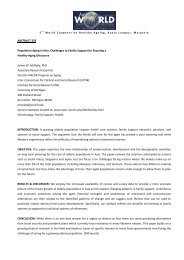The Pseudodementia Dilemma - 1st World Congress on Healthy ...
The Pseudodementia Dilemma - 1st World Congress on Healthy ...
The Pseudodementia Dilemma - 1st World Congress on Healthy ...
Create successful ePaper yourself
Turn your PDF publications into a flip-book with our unique Google optimized e-Paper software.
Ganser’s syndrome<br />
• In modern psychiatry, difficulty in interpreting much of this<br />
literature is the nebulous criteria used to define the<br />
syndrome<br />
• Enoch & Trethowan (1979) proposed a set of 4 criteria –<br />
approximate answers, clouding of c<strong>on</strong>sciousness, visual<br />
and auditory hallucinati<strong>on</strong>s and somatic c<strong>on</strong>versi<strong>on</strong><br />
symptoms<br />
• DSM-3 preserved the ‘repressi<strong>on</strong>’ of the syndrome’s<br />
‘hysteric’ character, enlisting it am<strong>on</strong>g factitious disorders<br />
together with Munchausen syndrome but the<br />
‘hysteric/dissociative’ character was later recognized by<br />
the newer diagnostic systems<br />
• Change in c<strong>on</strong>sciousness, as well as c<strong>on</strong>versi<strong>on</strong> symptoms,<br />
proof that this is a hysterical syndrome and not simple<br />
malingering<br />
• Thus, grouped under dissociative disorders in the DSM-4 (and<br />
-TR) and under other dissociative (c<strong>on</strong>versi<strong>on</strong>) disorders in<br />
ICD-10















